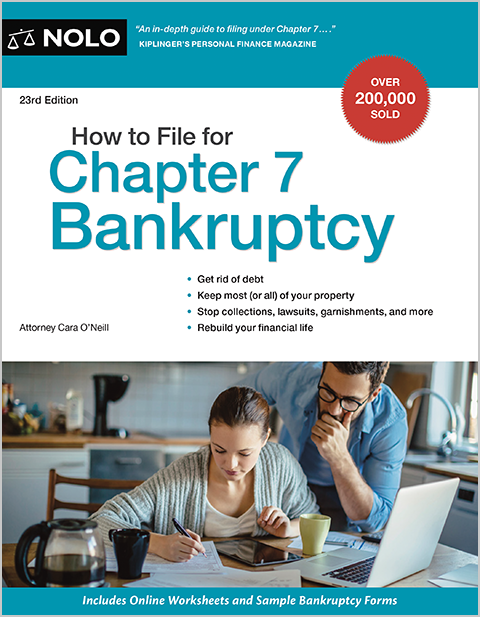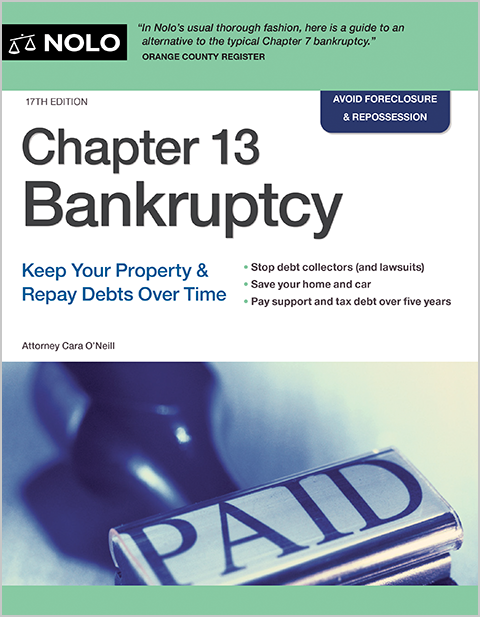Learn how debts are classified in bankruptcy, how they’re treated in Chapter 7 and Chapter 13 cases, and what debt claims can survive.
Filing for bankruptcy involves disclosing your debts, or "creditor claims," on official bankruptcy paperwork. But as easy as that might sound, classifying claims can get a bit tricky.
First, you'll list the debt as either a secured or unsecured claim. Then, you'll divide the unsecured claims into priority and nonpriority unsecured claims. In this article, you'll learn how to properly label each debt and find out what will happen to it in bankruptcy.
Listing Creditor Claims in Your Bankruptcy Paperwork
A bankruptcy case gets started after you complete and file official bankruptcy forms. The cover document, called the "petition," is where you'll disclose identifying information, such as your name, address, and the bankruptcy chapter you're filing. You'll provide details about your income, creditor claims (debts), and assets on forms called "schedules."
Creditor claims will appear on one of two schedules:
- Schedule D: Creditors Who Hold Claims Secured By Property. Here you'll include secured claims, such as a mortgage, a car payment, or another collateralized obligation.
- Schedule E/F: Creditors Who Have Unsecured Claims. You'll list unsecured claims on this form. Priority unsecured claims, such as unpaid taxes and child support, belong in Part 1. You'll list your nonpriority unsecured claims (all remaining debts) in Part 2.
What Is a Secured Claim?
A creditor with a secured claim has two contracts with you, the borrower. In one, the lender agrees to lend you money and you agree to pay it back. In the second contract, you give the lender a lien (also called a "security interest") on a piece of property you own.
If you don't pay according to the terms of your contract, the lien allows the lender to recover the property, sell it at auction, and apply the proceeds to the account balance. For instance, a mortgage lender with a lien can recover real estate in a foreclosure action, and a vehicle loan lender with a lien can recover a car through repossession.
Secured claims are often voluntary. For instance, if you agree to pledge an asset as collateral for the loan (a common practice when buying a house or car), you voluntarily give the creditor a security interest in your property.
Creditors can also obtain an involuntary lien against your property without your consent. For instance, a credit card company can get an involuntary lien after suing you in a collection lawsuit and winning a money judgment. When you fall behind on your taxes, statutory law gives the IRS the right to a tax lien against your property.
Common examples of secured bankruptcy claims include:
- mortgages
- car loans
- unpaid real estate taxes, and
- other property liens.
You'll list all secured claims on Schedule D: Creditors Who Hold Claims Secured By Property.
What Happens to Secured Creditors in Bankruptcy?
A creditor with a secured claim is in a good position. A bankruptcy discharge (the order that wipes out debt) won't get rid of a lien on your property. It only eliminates your liability to pay the debt.
Because the lien usually remains, the creditor can still foreclose or repossess the property if the loan doesn't get paid. So if you file for bankruptcy and want to keep property securing a loan, you'll have to continue making payments to the lender until you pay off the debt.
However, if there's significant equity in a house or car, a Chapter 7 trustee will likely sell it. But, because of the lien, the trustee must get enough to pay off the loan, return any exemption amount to you (the amount of equity you're allowed to protect), and use the remaining funds to pay off creditors. If there isn't enough equity to pay something meaningful to creditors, the trustee won't sell the property. (You can find out more about how this process works by reading Will I Lose My Home If I File for Chapter 7 Bankruptcy?)
If a property you'd like to keep has significant equity, a Chapter 13 case will likely be a better option. But you'll have to have enough income to pay a hefty monthly payment for three to five years (you must pay the value of the nonexempt equity in the plan). (Learn more by reading Keep Your House With Chapter 13 Bankruptcy.)
(Find out more about filing adversary proceedings in bankruptcy.)
What Are Unsecured Claims?
A creditor with an unsecured claim has a promise to pay from the borrower but doesn't have a lien. There are two types of unsecured claims:
- Priority unsecured claims. These debts aren't dischargeable in bankruptcy, and, if money is available, the claim will get paid before nonpriority unsecured claims.
- Nonpriority unsecured claims. Most of these obligations are dischargeable in bankruptcy (except student loans). All priority debts must be satisfied before these debts can be paid with bankruptcy funds.
You'll list unsecured claims on Schedule E/F: Creditors Who Have Unsecured Claims.
(For a comprehensive list of unsecured claims, see What Is an Unsecured Debt?)
What Happens to Unsecured Creditors in Bankruptcy?
Because they have no collateral that can be liquidated to satisfy the debt, unsecured claims have lower payment priority than secured claims and are only paid to the extent that funds are available. How they're paid and how much they're paid depend on whether the Bankruptcy Code classifies them as priority or nonpriority unsecured claims.
Priority Unsecured Claims
Priority unsecured debts aren't dischargeable in a Chapter 7 bankruptcy case. They also receive special treatment in that they are paid before nonpriority unsecured claims.
The following are some of the most common types of priority claims:
- alimony
- child support
- income tax obligations incurred within the last three years, and
- debts for personal injury or death caused by drunk driving.
You can't wipe out priority debts in Chapter 7 bankruptcy, but the bankruptcy trustee might sell some of your nonexempt property and apply the proceeds to the priority debt. If the trustee can't satisfy the priority claim, you'll be responsible for paying any balance that remains after your Chapter 7 case is completed.
If you file for Chapter 13 bankruptcy, you'll have to pay off priority unsecured debts in full through your three- to five-year repayment plan.
Nonpriority Unsecured Claims
The bankruptcy discharge will eliminate most types of nonpriority unsecured claims, but not all. Some of the most common nonpriority unsecured claims you can discharge in bankruptcy include:
- credit card debt
- medical bills, and
- personal loans.
Although student loans are unsecured debts, you can't discharge them unless you can prove that it would be an undue hardship to pay them (which is a difficult standard to prove).
(See Student Loans and Bankruptcy for more information.)
In most Chapter 7 bankruptcy cases, the debtor doesn't have enough nonexempt property to pay off the unsecured claims. Nevertheless, as long as it appears that selling the nonexempt property will net enough proceeds to pay a meaningful amount of the unsecured creditors' claims, the trustee will liquidate the nonexempt property.
Here are two examples of liquidating nonexempt property for unsecured claims:
Example 1: In your bankruptcy schedules, you listed both types of unsecured debt: $15,000 in past due child support, which is a priority debt, and $35,000 in nonpriority credit cards and medical bills. You also listed nonexempt assets of $10,000. If the trustee were to liquidate the nonexempt assets, all the proceeds would be paid on the past due child support claim because it is a priority debt. But, the amount wouldn't be enough to cover the entire child support claim. You would emerge from Chapter 7 having discharged the $35,000 in credit cards and medical bills. But, you would still owe the nondischargeable balance of $5,000 on the child support.
Example 2: Again, you listed $15,000 in past due child support and $35,000 in nonpriority credit cards and medical bills. This time your nonexempt assets total $25,000. That's enough to pay off the child support claim with $10,000 left over, which isn't enough to pay 100% on each nonpriority unsecured claim. Instead, the trustee will pay a pro rata percentage of each claim–$10,000 divided by $35,000, or approximately 28% of each debt. The remainder of each claim will go unpaid. But, because the debts are dischargeable, you'll no longer be liable on them after your Chapter 7 bankruptcy.
If you file a Chapter 13 case, in either of these scenarios you'll have to propose a plan that will ensure that you pay the $15,000 in past due child support over the three- to five-year plan. You won't be required to pay 100% of the nonpriority claims, and the remaining balances will be discharged.
Working With a Bankruptcy Attorney
Figuring out how your secured, priority, and unsecured claims will be treated in a bankruptcy case can be frustrating, and a mistake can cost you a lot of money. Many consumer bankruptcy attorneys offer free initial consultations to help prospective clients consider strategies to deal with issues and to ensure that clients understand the bankruptcy process. If you're wondering how bankruptcy can help you get a fresh financial start, make an appointment today.
- Listing Creditor Claims in Your Bankruptcy Paperwork
- What Is a Secured Claim?
- What Happens to Secured Creditors in Bankruptcy?
- (Find out more about filing adversary proceedings in bankruptcy.)
- What Are Unsecured Claims?
- What Happens to Unsecured Creditors in Bankruptcy?
- Working With a Bankruptcy Attorney

